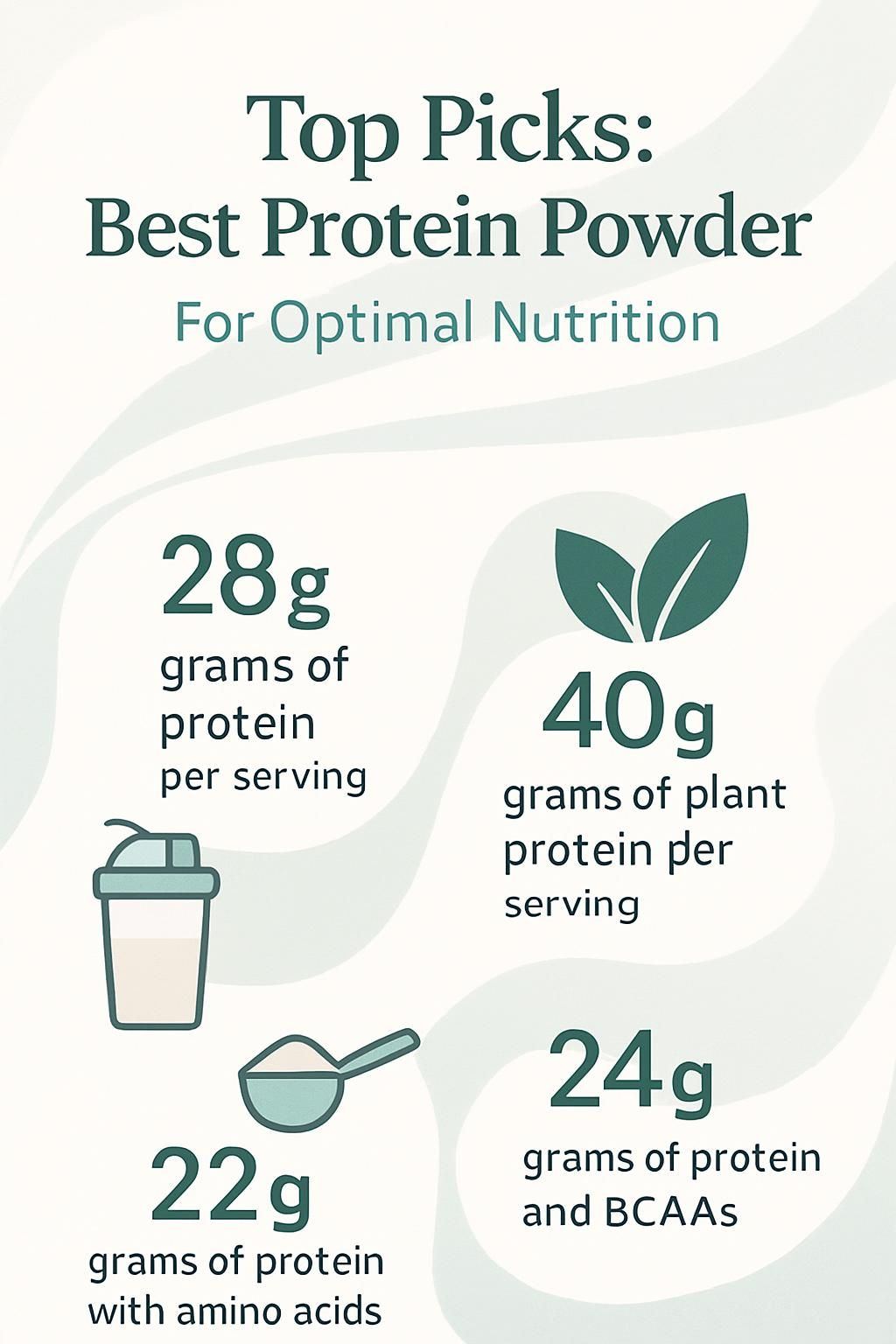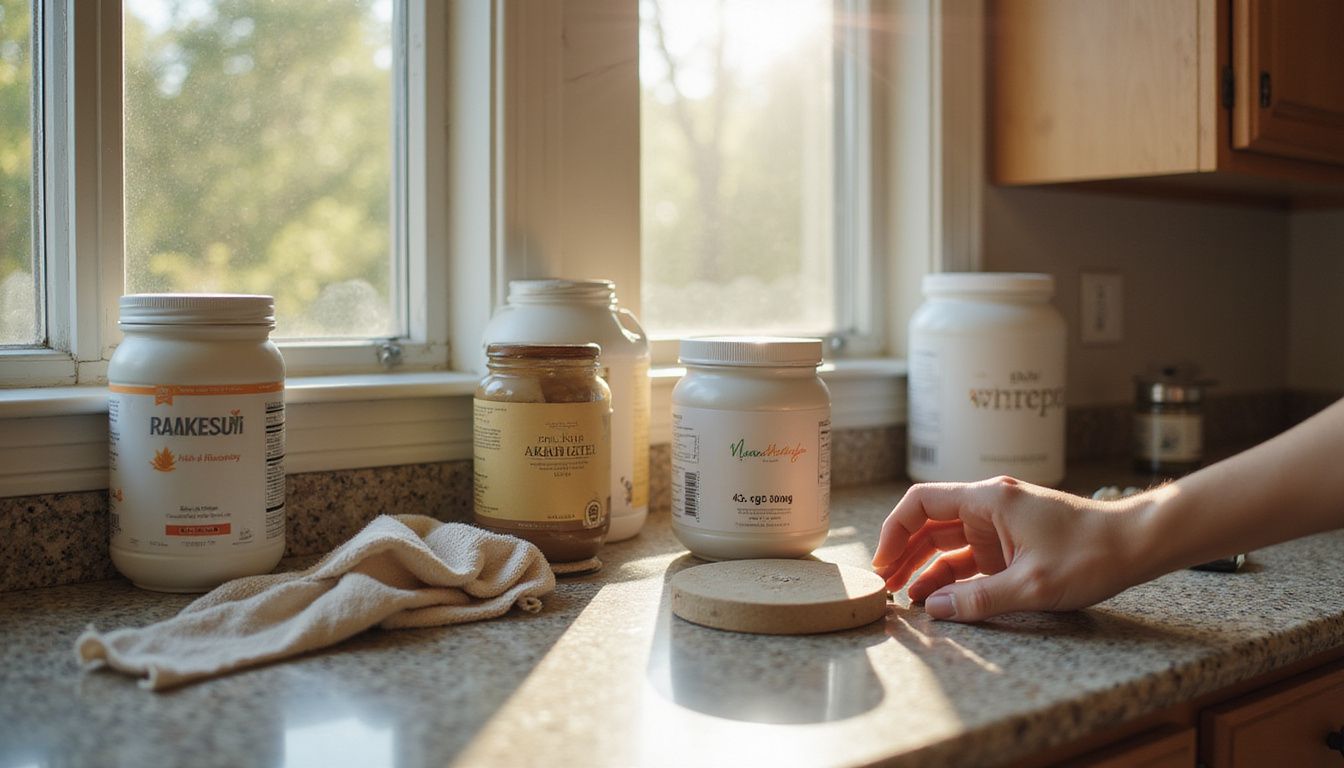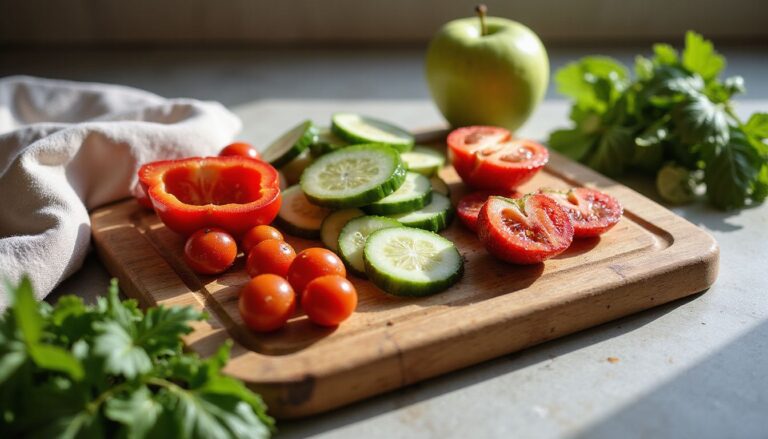Top Picks: Best Protein Powder For Optimal Nutrition
Our Nutrition Assistant AI Suite will transform your body. You will lose fat, get toned, and build muscle. Gain confidence and optimal health.
Struggling to choose the best protein powder for your goals? The right pick helps you build muscle, manage weight, and support daily nutrition.
This guide compares popular protein powders, explains key ingredients in plain language, and shares top picks for different needs. Keep reading to find a protein powder that fits your routine and taste.
Key Takeaways
- Transparent Labs 100% Grass-Fed Whey Protein Isolate delivers 28 grams of protein, has third-party testing, and uses no artificial sweeteners or colors.
- Huel Black Edition offers 40 grams of plant protein, no added sugar, and 26 essential vitamins and minerals for weight control.
- Swolverine Plant Protein provides 22 grams of protein from pea, pumpkin seed, hemp, and quinoa for a complete amino acid profile without major allergens.
- Optimum Nutrition Gold Standard 100% Whey gives 24 grams of fast-absorbing protein, includes BCAAs and glutamine, and comes in more than 20 flavors.
- Experts suggest choosing powders with 20 to 30 grams of protein per serving, clean labels, and third-party certifications for safety.

Why Protein Powder is Essential for Optimal Nutrition

Protein powder helps you meet daily protein needs without heavy prep. It supplies essential amino acids, the building blocks your body uses to repair tissue after exercise.
Many formulas support different goals. Some focus on faster recovery, while others emphasize satiety, weight control, or gentler digestion.
How does protein powder help with muscle growth and recovery?
Resistance training creates tiny muscle tears. Protein provides essential amino acids, including leucine, which signals muscle building. Whey protein is a complete protein, meaning it contains all nine essential amino acids your body cannot make.
Research shows that 20 to 40 grams of high-quality protein after lifting supports muscle hypertrophy and faster recovery. Aiming for 1.2 to 2.0 grams of protein per kilogram of body weight per day helps you gain or maintain muscle mass.
Casein digests slowly and releases amino acids for hours, which makes it useful before sleep. Plant-based options like pea or soy also support recovery when used consistently.
Mix a scoop with water or milk for a quick post-workout protein shake. This habit helps rebuild muscle and supports a healthy metabolism while you meet daily protein goals.
How does protein powder support weight management and overall health?
Protein increases fullness and reduces cravings. Options like whey isolate or plant blends from pea and soy slow digestion, which can reduce snacking and help control calories.
Studies suggest about 25 grams of protein per meal can lower intake at the next meal. Using a protein shake at breakfast or as a snack makes it easier to stay within your calorie target while still getting key nutrients.
“Evidence shows increasing protein intake helps maintain muscle during weight loss.”
Higher daily protein supports muscle retention during fat loss and may limit muscle atrophy. Some powders, such as collagen and casein, may also support joint comfort, skin elasticity, and gut health for active people.
Choosing clean products without added sugar or artificial sweeteners reduces empty calories and keeps labels simple.
^1: Evidence suggests eating more complete proteins, those containing all nine essential amino acids, contributes positively to healthy tissue maintenance (Harvard T.H. Chan School of Public Health).
Types of Protein Powders
Protein powders vary by source and digestion speed. Common choices include whey, casein, plant-based blends, and collagen, each serving a different goal.
What are the differences between whey protein concentrate, isolate, and hydrolyzed?
Whey protein comes in three main forms. Each differs in protein content, lactose content, and absorption speed. These factors influence tolerance, taste, and price.
| Type | Protein Content (per 100g) | Lactose Content | Processing Method | Absorption Rate | Best For | Price Range |
|---|---|---|---|---|---|---|
| Whey Concentrate | ~70-80g | Moderate | Filtered to remove some fat and carbs | Moderate | Everyday use, budget-conscious users | Low to Moderate |
| Whey Isolate | ~90-95g | Very Low | Further filtration removes more fat and carbs | Fast | Lactose-intolerant, cutting phases | Moderate to High |
| Hydrolyzed Whey | ~90-95g | Low | Enzymatic breakdown for pre-digestion | Very Fast | People with sensitivities, rapid recovery | High |
- Whey concentrate balances protein content and cost for daily use.
- Whey isolate offers higher purity and suits many with lactose sensitivity.
- Hydrolyzed whey is pre-broken for very fast absorption, helpful during heavy training blocks.
What are the benefits of slow-digesting casein protein?
Casein digests slowly in the gastrointestinal tract. This steady release of amino acids can last for up to eight hours.
A scoop often provides about 24 grams of protein. Taken before bed, it helps reduce overnight muscle breakdown and supports repair.
Many athletes use casein at night to curb hunger and support recovery. Mixing it with milk and a spoon of peanut butter creates a thicker shake that keeps you satisfied until morning.
Casein protein is a popular choice for those wanting longer-lasting muscle support, especially during overnight recovery.
Which plant-based proteins are best: pea, soy, or rice?
Pea protein is rich in essential amino acids and is close to complete. It blends well in smoothies with a mild taste.
Soy protein is a complete protein and supports muscle gain similar to dairy-based options. Typical scoops of pea or soy provide 15 to 25 grams of protein.
Brown rice protein is hypoallergenic and gluten-free. It is low in lysine, so pairing it with pea protein creates a complete amino acid profile.
Try mixing rice and pea powder into oatmeal before a workout. The texture stays smooth and the combo fuels longer sessions.
How does collagen protein improve skin and joint health?
Collagen protein supports connective tissues, including skin, cartilage, and tendons. Collagen peptides are short chains of amino acids that your body can use to build or repair these structures.
Regular intake may improve skin elasticity and reduce fine lines. Some studies suggest about 10 grams per day can reduce joint discomfort in active people after several months.
If flexibility or joint comfort is a priority, collagen can be a useful add-on. It is not ideal for muscle building on its own, so pair it with a complete protein if strength gains are your main goal.
How to Choose the Best Protein Powder
Picking the right powder starts with protein per scoop, clean ingredients, and trusted testing. A short checklist keeps the choice simple.
How much protein should a serving contain?
Aim for 20 to 30 grams of protein per serving. This range supports recovery, appetite control, and daily needs for most adults.
Popular choices like Optimum Nutrition Gold Standard Whey provide about 24 grams per scoop. Hitting around 30 grams can help active people reach the Reference Daily Intake more easily.
Check the label so each scoop matches your goals and training volume. This keeps calories in line while you hit your target.
What ingredients should you look for or avoid in protein powder?
Skim the label for a short list of familiar ingredients. Fewer extras often means fewer surprises for your stomach.
- Choose clean sources such as whey isolate, pea protein, or egg protein for high protein content with fewer fillers.
- Limit added sugars like sucrose and corn syrup to keep carbs and calories in check.
- If you prefer fewer additives, avoid artificial sweeteners such as sucralose and aspartame.
- Pick flavors that rely on simple ingredients, for example vanilla or chocolate, without heavy flavoring agents.
- Avoid unnecessary thickeners and fillers, including hydrogenated oils and excessive gums, which may affect digestion.
- Look for third-party certifications to confirm purity and accurate labeling.
- Choose gluten-free options if you are sensitive, and check for soy or dairy if you have allergies.
- Added vitamins and minerals can help, but avoid blends with excessive or unbalanced fortification.
- Clear protein types, such as milk protein isolate or hydrolyzed whey, increase transparency.
- Favor powders that mix smoothly without grit for better taste and easy use.
Why are third-party testing and certifications important?
Independent testing confirms what is on the label is in the tub. Labs screen for heavy metals, banned substances, microbes, and undeclared fillers.
Seals such as NSF Certified for Sport or Informed-Sport signal tighter quality standards. Many athletes prefer certified powders for safety during drug-tested events.
Badges like non-GMO, organic, or gluten-free may also guide your choice. Testing supports safe use and gives confidence in your supplement routine.
How do flavor, mixability, and texture affect your choice?
Great taste and smooth texture make daily use easier. A chalky shake often ends up in the sink.
Pick flavors you enjoy, like chocolate or vanilla. Good mixability matters for quick shakes, baking, and stirring into oatmeal. Silky powders dissolve well, so you can drink protein without clumps or grit.
Now, see why Transparent Labs 100% Grass-Fed Whey Protein Isolate earns the top spot for many users.
Best Overall Protein Powder: Transparent Labs 100% Grass-Fed Whey Protein Isolate
Transparent Labs uses whey protein from grass-fed cows and skips artificial sweeteners. The formula focuses on purity, taste, and label accuracy.
What are the key features of Transparent Labs 100% Grass-Fed Whey Protein Isolate?
Each serving supplies 28 grams of whey protein isolate with only a small amount of carbs and sugar. The milk comes from cows not treated with growth hormones, which supports a high biological value for muscle repair.
Natural flavors and stevia replace sucralose or aspartame. Third-party testing checks for heavy metals and banned substances.
The powder mixes smoothly in water or milk without clumping. It suits people who want a clean protein source for weight control and training, including those concerned about age-related muscle loss.
What are the pros and cons of Transparent Labs 100% Grass-Fed Whey Protein Isolate?
Transparent Labs stands out for ingredient quality and strong nutrient density. Here is a quick look at benefits and trade-offs.
- Grass-fed whey isolate from hormone-free cows supports recovery and lean muscle building.
- Delivers 28 grams of complete protein, including leucine and isoleucine for repair after training.
- No artificial sweeteners, dyes, or harsh additives; avoids sugar alcohols that may upset digestion.
- Third-party testing improves trust in label accuracy and product safety.
- Flavor options include simple choices like mint and chocolate without heavy aftertaste.
- Mixes easily for shakes or recipes such as oatmeal or smoothies.
- Costs more than budget options due to sourcing and processing quality.
- Not suitable for vegan diets; plant-based alternatives may be a better fit for some users.
Next, compare features and value with a budget-friendly whey concentrate.
Best Budget-Friendly Protein Powder: Nutricost Whey Concentrate
Nutricost Whey Concentrate offers solid protein at a lower price. It keeps the ingredient list simple for people who want value without many extras.
What features does Nutricost Whey Concentrate offer?
Each serving contains about 25 grams of protein to support muscle growth and recovery. The powder focuses on whey concentrate for an affordable yet effective protein source.
Ingredients are kept minimal to avoid unnecessary fillers. It mixes well in water or milk and comes in several flavors that do not overwhelm your recipes.
Budget-minded shoppers often choose this option to meet daily protein targets at a lower cost.
What are the advantages and disadvantages of Nutricost Whey Concentrate?
Nutricost provides a simple and affordable way to add more protein. Consider these points before buying.
- Lower price per serving than many popular protein powders.
- About 25 grams of protein per scoop fits most training plans.
- Mixes easily and has a mild taste for shakes, oats, or baking.
- Fewer added ingredients than some competitors.
- Whey concentrate retains bioactive components, but it contains more lactose than isolate.
- People with lactose intolerance may notice mild digestive issues.
- Lacks third-party certifications, so quality assurance relies on the brand.
- Flavor and texture may not match premium blends, though performance is reliable for the price.
Best Protein Powder for Weight Loss: Huel Black Edition
Huel Black Edition pairs high protein with fewer carbs and no added sugar. It combines pea and rice proteins to create a complete amino acid profile.
What makes Huel Black Edition good for weight loss?
A 90-gram serving delivers 40 grams of plant protein for strong fullness and muscle retention. Carbohydrates stay under 17 grams per serving, which can help limit calorie intake.
There are no added sugars or artificial sweeteners. It is gluten-free and contains all essential amino acids, plus 26 vitamins and minerals. At about 400 calories per serving, it works as a balanced meal shake.
What are the pros and cons of Huel Black Edition?
Huel Black Edition supports appetite control and nutrient coverage in one scoop. Here are the key points.
- 40 grams of plant protein supports recovery and muscle maintenance.
- Pea and rice protein together provide a complete amino acid profile.
- No artificial sweeteners and gluten-free for sensitive diets.
- Includes 26 essential vitamins and minerals per serving.
- Only 4 grams of sugar per serving helps manage daily sugar intake.
- High protein and fiber support weight management strategies.
- Some users notice a chalky texture or aftertaste.
- Higher cost than many basic whey proteins.
- Certain users report digestion issues with pea-based formulas.
- Limited flavor options and mixability can reduce daily enjoyment.
Best Vegan Protein Powder: Swolverine Plant Protein
Swolverine uses a multi-source plant blend to deliver complete protein without dairy or soy. It aims for clean ingredients, smooth texture, and steady digestion.
What features define Swolverine Plant Protein?
This blend combines pea, pumpkin seed, hemp, and quinoa to complete the amino acid profile. Each scoop has 22 grams of protein for recovery and muscle support.
The formula avoids added sugars and artificial sweeteners. It mixes smoothly in water or nut milk without clumps or grit.
All ingredients are non-GMO and gluten-free. Natural micronutrients from quinoa and pumpkin seeds add extra support for active lifestyles.
What are the benefits and drawbacks of Swolverine Plant Protein?
Swolverine delivers complete plant protein with clear sourcing. Consider the following before you try it.
- 22 grams of protein per serving supports recovery similar to some dairy-based options.
- Full amino acid profile from complementary plant sources.
- Free of artificial sweeteners, added sugars, dairy, gluten, and soy.
- Smooth mixability in water or almond milk without clumps.
- Many users report easy digestion with minimal bloating.
- Mild flavor profile that suits blends and smoothies.
- Higher price per serving than basic whey or single-source plant proteins.
- Leucine content is lower than some dairy proteins, which may slow rapid post-workout recovery in very intense training.
Up next, a whey isolate that many women prefer for clean nutrition and easy mixing.
Best Protein Powder for Women: Kaged Whey Protein Isolate
Kaged Whey Protein Isolate focuses on clean ingredients, low sugar, and strong mixability. It supports lean muscle goals with fewer calories per scoop.
What are the features of Kaged Whey Protein Isolate tailored for women?
Each serving provides 25 grams of whey protein isolate with less than 1 gram of sugar. The gluten-free formula has no artificial colors or flavors.
Digestive enzymes are included to support absorption and reduce stomach discomfort. The powder mixes smoothly in water or milk without clumps.
At 110 calories per scoop, it works well for weight control or muscle toning. The low-carb profile fits active routines that target lean mass.
What are the pros and cons of Kaged Whey Protein Isolate?
Kaged aims for high quality and transparency. Review these points before you add it to your cart.
- 25 grams of protein per serving with very low sugar supports lean goals.
- Third-party testing for banned substances adds safety and trust.
- Digestive enzymes may reduce bloating and improve comfort.
- Excellent mixability for smooth shakes and recipes.
- Naturally sourced flavors without artificial sweeteners, colors, or flavors.
- Higher price than many standard whey powders.
- Flavor selection is more limited than some competitors.
- Whey is sourced from non-GMO cows not treated with growth hormones.
- Lactose is very low, though highly sensitive users should still monitor tolerance.
- Informed-Sport certification supports use in drug-tested events.
Best Protein Powder for Muscle Gain: Optimum Nutrition Gold Standard 100% Whey
Optimum Nutrition Gold Standard 100% Whey is popular for muscle gain and fast recovery. It blends quickly, tastes good, and fits most plans.
What features make Optimum Nutrition Gold Standard 100% Whey ideal for muscle gain?
Each serving provides 24 grams of protein to fuel recovery after workouts. The blend of isolate, concentrate, and peptides supports quick absorption.
Carbs sit around 3 grams, with about 1 gram of sugar per scoop. BCAAs and glutamine help reduce soreness and support muscle repair.
Mixability is strong in water or milk, with more than 20 flavors to prevent taste fatigue. Hitting your daily protein targets becomes much easier.
What are the pros and cons of Optimum Nutrition Gold Standard 100% Whey?
Gold Standard Whey balances quality, flavor variety, and consistent results. Here is what to weigh.
- 24 grams of high-quality whey supports muscle repair and growth.
- Mixes smoothly with minimal clumping for quick shakes.
- Large flavor lineup helps you stick to your plan.
- Low sugar per serving supports calorie control.
- Transparent labels and third-party quality checks improve confidence.
- Includes sucralose and acesulfame potassium, which some users prefer to avoid.
- Costs more than some budget whey powders.
- A few users report mild bloating from the whey blend.
- Contains soy lecithin for mixability, which matters for those with soy allergies.
How to Use Protein Powder Effectively
Timing and pairing matter. A few small tweaks can improve your results day by day.
When is the best time to take protein powder: before or after a workout?
Most evidence supports taking 20 to 30 grams of protein soon after training. Your muscles are primed to use amino acids for repair and growth during this window.
A small serving before workouts can help if you train fasted or need more energy. For most gym-goers, post-workout remains the simplest and most reliable choice.
What are the best liquids or foods to mix protein powder with?
Water, milk, or plant milks like almond and oat make smooth shakes. Greek yogurt or cottage cheese create thick, protein-rich snacks. Blending with frozen fruit and spinach adds fiber and vitamins for a balanced smoothie.
Stir protein into oatmeal, pancake batter, or overnight oats for a filling breakfast. After workouts, a shake with skim milk and berries tastes great and supports recovery.
Some research suggests pairing protein with dairy may support muscle protein synthesis[1]. Unflavored protein can also boost soups or stews without changing taste.
Reference:
[1] Tang JE, et al., “Ingestion of whey hydrolysate, casein, or soy protein isolate: Effects on mixed muscle protein synthesis at rest and following resistance exercise in young men.” J Appl Physiol (2009).
How can you add protein powder to meals and snacks?
Mix powder into smoothies or milk for quick shakes. Add it to oatmeal, pancake or waffle batter, and yogurt for easy protein boosts.
Bake into muffins or energy bites for grab-and-go options. Stir unflavored powder into soups, mashed potatoes, or pasta sauces for extra protein without extra taste.
Dietitians often suggest 15 to 25 grams of protein per meal to support muscle and manage hunger[1]. Small changes across breakfast, lunch, and snacks can help you meet daily targets even on busy days.
…
[1] American College of Sports Medicine: Nutrition and Athletic Performance, 2016
Key Factors to Avoid in Protein Powders
Some powders add sugars or fillers that work against your goals. A quick label check can spare you headaches and extra calories.
Why should you avoid added sugars and artificial sweeteners?
Added sugar raises calories and may increase the risk of heart disease, type 2 diabetes, and tooth decay. The American Heart Association suggests limiting added sugar to less than 25 grams per day for women and 36 grams for men.
Artificial sweeteners are low calorie but may upset digestion in some people. Early research also suggests possible changes in gut bacteria and blood sugar control. Choosing unsweetened or lightly sweetened powders keeps things simpler.
What harmful additives and fillers should you watch out for?
Certain additives reduce nutrition quality or trigger stomach issues. Scan for these before you buy.
- Artificial sweeteners such as sucralose, aspartame, and acesulfame potassium can cause digestive discomfort and may alter gut bacteria.
- Thickeners like carrageenan and xanthan gum may lead to bloating in sensitive users.
- Hydrogenated oils raise LDL cholesterol and increase heart disease risk.
- High added sugars, listed as fructose, glucose syrup, or corn syrup solids, spike blood sugar.
- Synthetic coloring agents add no nutrition and may cause reactions in sensitive people.
- Fillers such as maltodextrin increase bulk and can raise blood sugar quickly.
- Preservatives like sodium benzoate or potassium sorbate can trigger headaches or allergies in some.
- Contaminants including lead, arsenic, cadmium, and mercury have been found in low-quality powders; third-party testing helps reduce this risk.
- Excess sodium may raise blood pressure over time.
- Hidden gluten or soy can cause problems if you have allergies or intolerances.
Choosing a clean protein powder supports better digestion and consistent progress.
Frequently Asked Questions (FAQs)
Here are quick answers to common questions so you can choose and use protein powder with confidence.
Is it safe to consume protein powder every day?
For most healthy adults, daily use is safe within total protein needs. The International Society of Sports Nutrition notes up to 2.0 grams of protein per kilogram of body weight per day is safe for many adults.
Pick products with simple labels and third-party testing. If you have kidney or liver issues, talk with a healthcare professional before using protein supplements regularly.
Which protein powders are the cleanest on the market?
Look for minimal ingredients and trusted certifications. Transparent Labs, Legion Whey+, and Naked Nutrition focus on simple formulas without artificial sweeteners or dyes.
Examples include Transparent Labs 100% Grass-Fed Whey Protein Isolate, which lists a short ingredient panel, and Naked Pea Protein, which uses a single ingredient. Seals like NSF Certified for Sport or Informed-Sport indicate strong quality checks.
Can protein powder be used as a meal replacement?
Protein powder alone is usually not a full meal because it often lacks enough carbs, fats, and micronutrients. You can build a meal replacement by blending protein with fruit, leafy greens, nut butter, chia seeds, or oats.
Adjust the recipe based on your calorie and nutrient needs. If you are unsure, ask a registered dietitian for guidance on portion sizes and timing.
Conclusion
The best protein powder helps you meet daily protein needs, build muscle, and manage weight. Transparent Labs Whey Isolate, Huel Black Edition, Swolverine Plant Protein, and Optimum Nutrition Gold Standard Whey each serve different goals.
Choose 20 to 30 grams of protein per serving, look for clean labels, and prefer third-party testing. Pick flavors you enjoy so you use protein consistently. With a smart choice and steady habits, your protein shake can support stronger workouts and better meals every day.
FAQs
1. What makes a protein supplement the best choice for optimal nutrition?
A top protein supplement offers high-quality amino acids, low added sugars, and minimal artificial additives. Scientific reviews show that whey concentrate and pea-based blends provide complete proteins with all essential amino acids needed for muscle repair and growth.
2. How do I compare nutritional content in different protein supplements?
Review the label for grams of protein per serving, total calories, fat content, carbohydrate amount, and micronutrients like calcium or iron. For example, one scoop of soy isolate often contains 20 to 25 grams of protein with less than two grams of sugar.
3. Are plant-based powders as effective as animal-derived options?
Research published in peer-reviewed journals indicates that both plant-based blends such as rice-pea mixes and dairy-derived products like casein support muscle health when consumed at similar daily amounts.
4. Can you share a personal experience using these supplements?
After switching from milk-based powder to a blend made from peas and brown rice due to lactose intolerance, I noticed improved digestion without sacrificing energy during workouts or recovery time after exercise sessions.
Summary: Choosing the right supplement involves comparing ingredients lists for quality sources of protein while considering dietary needs such as allergies or intolerances. Both animal- and plant-sourced powders can help meet daily requirements if selected carefully based on scientific evidence.







